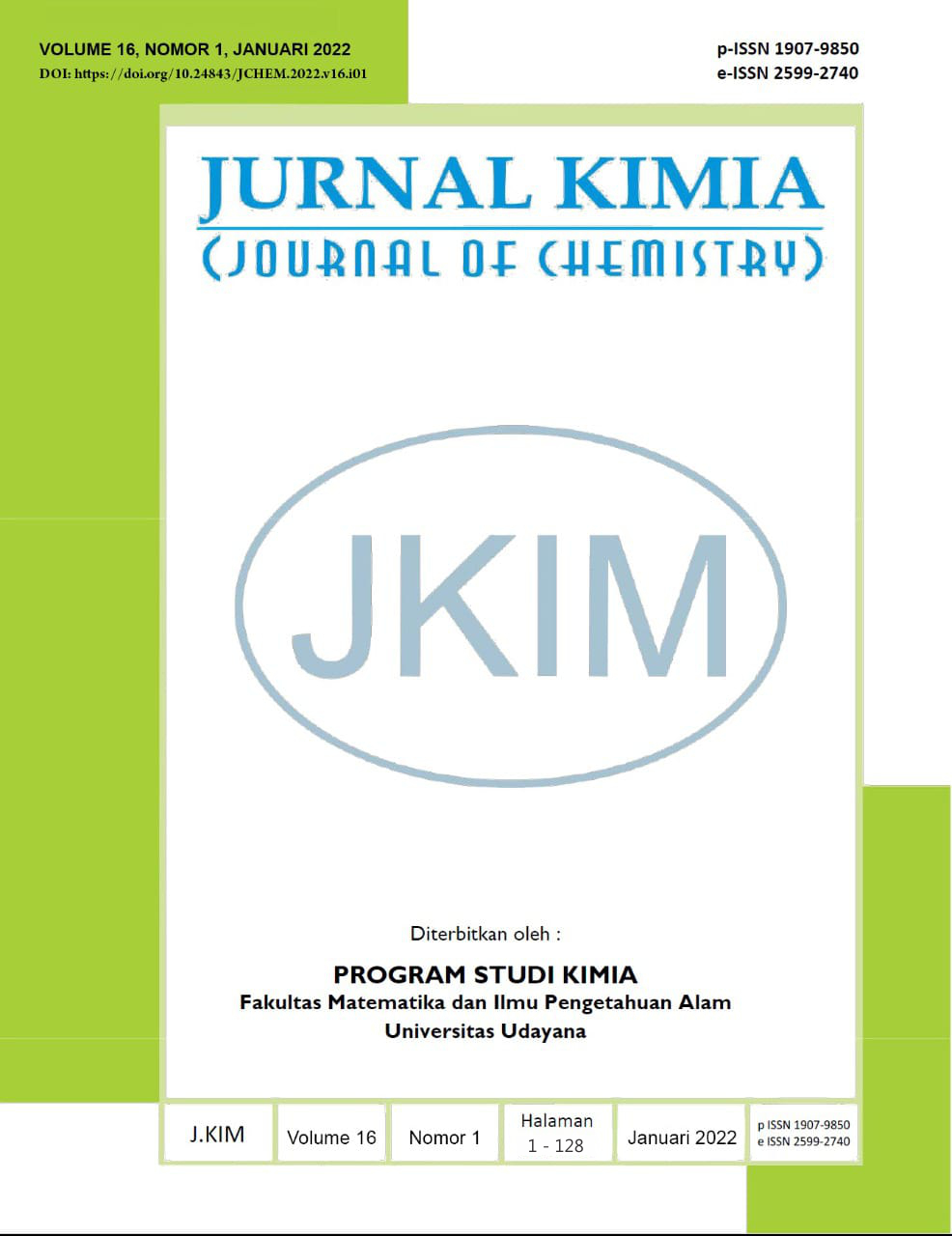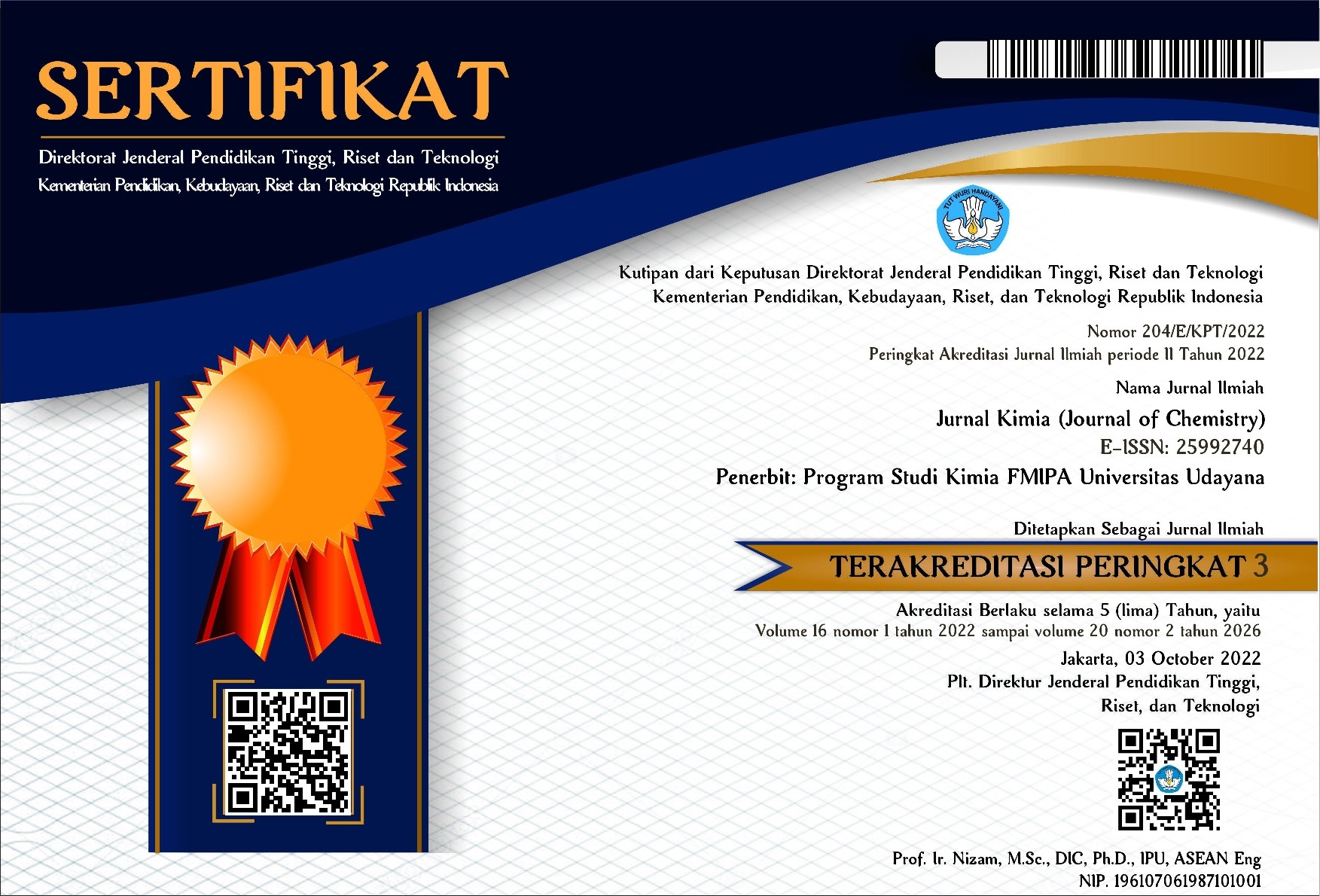IDENTIFIKASI SERTA UJI AKTIVITAS ANTIBAKTERI SENYAWA FLAVONOID EKSTRAK DAUN SRIKAYA (Annona squamosa Linn)
Abstract
Salah satu tanaman yang memiliki kandungan senyawa flavonoid yang sering dimanfaatkan sebagai obat tradisional di Indonesia adalah tanaman srikaya (Annona squamosa Linn). Isolasi, identifikasi serta uji aktivitas antibakteri senyawa flavonoid dari ekstrak daun srikaya terhadap bakteri Staphylococcus aureus dan Escherichia coli dengan metode sumur difusi telah dilakukan pada penelitian ini. Serbuk daun srikaya dengan kadar air 8% dimaserasi menggunakan metanol lalu dievaporasi hingga diperoleh ekstrak kental 113,85 g. Ekstrak tersebut dipartisi dengan pelarut n-heksana, etil asetat dan n-butanol yang menghasilkan 3,43 gram ekstrak n-heksana, 2,30 g ekstrak etil asetat dan 3,85 g ekstrak n-butanol. Uji fitokimia menunjukkan bahwa ekstrak etil asetat positif mengandung flavonoid dengan kadar total flavonoid terbanyak 26.117,4 mg QE/100 g. Isolat F5 hasil pemisahan serta pemurnian dari ekstrak etil asetat, positif mengandung flavonoid dan relatif murni secara kromatografi lapis tipis. Identifikasi isolat F5 dengan spektrofotometer UV-Visible dan Fourier-Transform Infrared (FTIR) menunjukkan dua pita serapan yaitu pada ? maks 376,40 nm (pita I) dan 256,40 nm (pita II) serta mengandung dugaan gugus fungsi yang terdapat dalam senyawa flavonoid yaitu OH, C=C aromatik, C-H alifatik, C-H aromatik, C-O eter dan C-O alkohol. Isolat tersebut mampu menghambat pertumbuhan bakteri Staphylococcus aureus dan Escherichia coli pada konsentrasi 15% (b/v) dengan diameter hambat secara berturut-turut sebesar 7,75 mm dan 7,25 mm. Hasil ini menunjukkan bahwa senyawa flavonoid hasil isolasi dari ekstrak daun srikaya diduga adalah 5,3’,4’-trihidroksiflavonol dan mempunyai aktivitas antibakteri dengan daya hambat sedang.
Kata kunci: antibakteri, daun srikaya (Annona squamosa Linn), isolasi flavonoid, 5,3’,4’-trihidroksiflavonol.
One of the plants containing flavonoid compounds, commonly used as traditional medicine in Indonesia, is srikaya (Annona squamosa Linn). Isolation, identification and antibacterial activity test of flavonoid compounds from srikaya leaf extract against Staphylococcus aureus and Escherichia coli by using diffusion well method have been done in this research. Srikaya leaf powder with 8% moisture content was macerated with methanol then evaporated until concentrated extract of 113.85 grams was obtained. The extract was partitioned with n-hexane, ethyl acetate and n-butanol solvents and produced 3.43 grams of n-hexane extract, 2.30 grams of ethyl acetate extract and 3.85 grams of n-butanol extract. The phytochemical test showed that the ethyl acetate extract positively contained flavonoids with the highest total flavonoid levels of 26,117.4 mg QE/100 grams. Isolate F5, as the result of separation and purification of ethyl acetate extract, was positive containing flavonoids and resulting relatively pure isolate, analyzed by thin layer chromatography. Identification of isolate F5 using spectrophotometer UV-Visible and Fourier-Transform Infrared (FTIR) showed two absorption bands at ? max of 376.40 nm (band I) and 256.40 nm (band II) as well as contained functional groups of flavonoid which was OH, C=C aromatic, C-H aliphatic, C-H aromatic, C-O ether and C-O alcohol. These isolates were able to inhibit the growth of Staphylococcus aureus and Escherichia coli at the concentration of 15% (w/v) with inhibitory diameter of 7.75 and 7.25 mm, respectively. These results indicated that flavonoids isolated from srikaya leaf extract were suspected 5,3’,4’-trihydroxyflavonol and had antibacterial activity with moderate inhibitory ability.
Keywords: antibacterial, flavonoid isolation, srikaya leaf (Annona squamosa Linn),5,3’,4'-trihydroxyflavonol.
Downloads
References
Chang, C., Yang M., and Wen H. C. J. 2002. Estimation of Total Flavonoid Content in Propolis by Two Complementary Colorimetric Methods. J.Food Drug Anal. 10: 178-182
Fischbach, M. A., and Walsh T. 2009. Antibiotics for Emerging Pathogen. Journal of Science. 325(5944): 1089-1093
Geissman, T. A. 1962. The Chemistry of Flavonoid Compound. New York: The Mac Millan Company.
Gowdhami, M., Sarkar B. L., and Ayyasamy P. M. 2014. Screening of Phytochemicals and Antibacterial Activity Of Annona squamosa Extracts. International Journal of Pharmaceutical Science Invention. 3(7): 30-39.
Hendra, R., Ahmad S., Sukari A., Shukor M.Y., and Oskoueian E. 2011. Flavonoid analysis and antimicrobial activity of various parts of Phaleria macrocarpa (Scheff) Boerl fruit. International Journal Molecular Science. 12: 3422-3431
Markham, K.R. 1988. Cara Mengidentifikasi Flavonoid. Bandung: A.B. Kosasih Padmawinata, Institut Teknologi Bandung.
Pawaskar, S. M., and Sasangan K. C. 2017. Preliminary Phytochemical and Invitro Antimicrobial analysis of Annona squamosa Linn. leaf extract. Journal of Pharmaceutical Sciences and Research. 9(5): 618-623
Priya, V. M., Jainu S. K., Mohan, Saraswhati, and Gopan C.S. 2010. Antimicrobial Activity of Pericarp Extract of Garcinia mangostana Linn. International Journal of Pharma Sciences and Research. 1(8): 278-281.
Tansil, A. Y. M., Edward N., Jimmy P., dan Robert. A. B. 2016. Uji Daya Hambat Ekstrak Etanol Daun Srikaya (Annona squamosa) Terhadap Pertumbuhan Bakteri Escherichia coli dan Staphylococcus aureus. Journal e-Biomedik. 4(2): 1-5.

This work is licensed under a Creative Commons Attribution 4.0 International License






